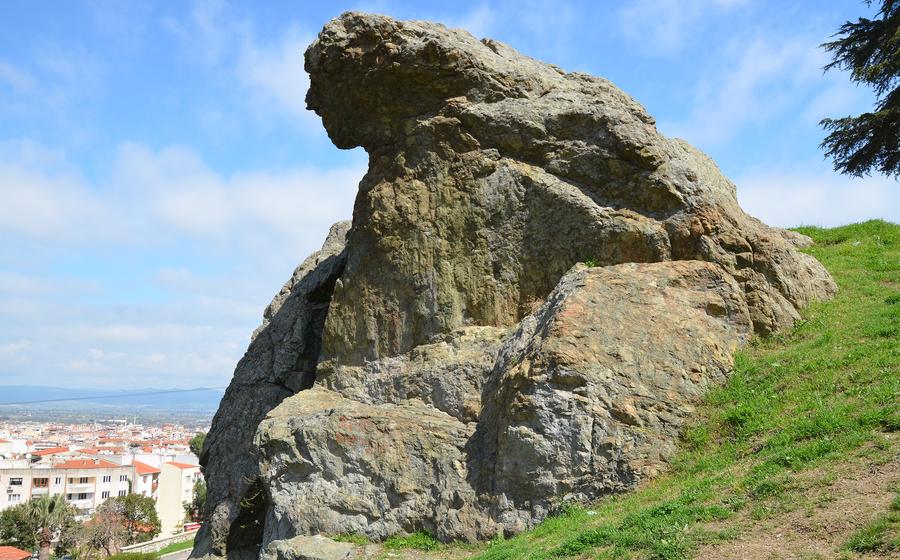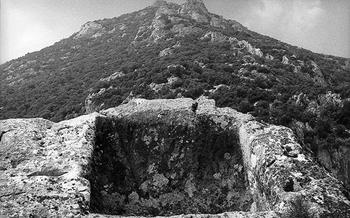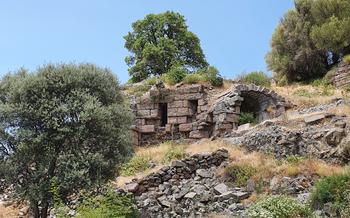
Niobe Weeping Rock
- Niobe Weeping Rock: An Ode to Tragedy
- Location and Accessibility
- Exploring the Mythological Tale
- Geological Significance
- Ancient Ruins Nearby
- Visiting Tips for Travelers
- Historical Context of Manisa
- Hiking and Nature Trails
- Local Culture and Cuisine
- Nearby Attractions
- Accommodation Options
- Photography Opportunities
- Myths and Legends of Manisa
- Sustainable and Responsible Tourism
- Insider Tip: Uncovering a Hidden Gem
Niobe Weeping Rock: An Ode to Tragedy
For many, the Niobe Weeping Rock isn't just a natural wonder; it's a poignant symbol of a mother's grief and the tragic consequences of arrogance.
In Greek mythology, Niobe, the proud queen of Thebes, dared to compare herself to the goddess Leto, who had borne only two children, Apollo and Artemis. Enraged by Niobe's hubris, Leto commanded her children to punish the mortal queen. Apollo killed Niobe's seven sons, while Artemis slew her seven daughters. In her immeasurable grief, Niobe wept until she turned into a stone, forever shedding tears that form the Niobe Weeping Rock.
Located in the Manisa province of Turkey, this natural rock formation bears a striking resemblance to a woman's face, her tears streaming down her cheeks. It's a testament to the enduring power of the Niobe myth and a reminder of the dangers of excessive pride.
Location and Accessibility
The Niobe Weeping Rock is situated in the picturesque city of Manisa, Turkey, approximately 30 kilometers north of the city center. It is nestled amidst lush greenery and rolling hills, offering visitors a serene and tranquil setting. The rock is easily accessible by car, with well-maintained roads leading directly to the site. For those without their own transportation, local buses and taxis are readily available to transport visitors to the Niobe Weeping Rock. The GPS coordinates for the site are 38°48'08"N 27°26'33"E, making it convenient for self-guided travelers to navigate their way. Whether you choose to drive, take public transportation, or embark on a leisurely walk, reaching the Niobe Weeping Rock is a hassle-free experience that allows you to seamlessly immerse yourself in the awe-inspiring natural wonder.
Exploring the Mythological Tale
The myth of Niobe, the arrogant queen who dared to challenge the gods, has its roots deep in Greek mythology. The story goes that Niobe, blessed with 14 beautiful children, seven sons, and seven daughters, boasted of her superiority over the goddess Leto, who had only two children, Apollo and Artemis. This hubris angered the gods, and Apollo and Artemis, in a fit of rage, killed all of Niobe's children with their arrows.
In the Roman version of the myth, Niobe is transformed into a weeping rock as punishment for her pride. Ovid, the Roman poet, describes how Niobe's tears turned into a constant stream, forming the Niobe Weeping Rock. The rock's location, on the slopes of Mount Sipylus, overlooking the ancient city of Magnesia, adds to its mythical significance.
The myth of Niobe serves as a cautionary tale against hubris and a reminder of the power of the gods. It has influenced art, literature, and popular culture for centuries, inspiring paintings, sculptures, and literary works. The Niobe Weeping Rock, as a physical manifestation of the myth, stands as a testament to the enduring power of storytelling and the human fascination with tales of tragedy and redemption.
Geological Significance
The Niobe Weeping Rock is not merely a mythological marvel; it also holds significant geological importance. The rock's unique formation is a result of natural processes that have shaped it over millions of years. Erosion and weathering, caused by wind, rain, and temperature fluctuations, have gradually carved the rock into its current form.
The composition of the rock is equally fascinating. It is primarily composed of limestone, a sedimentary rock formed from the accumulation of calcium carbonate. The limestone's layered structure, combined with the erosive forces of nature, has created the distinctive weeping effect that characterizes the rock.
The Niobe Weeping Rock is considered a natural wonder and a geological marvel due to its unique combination of geological processes and mythological associations. It serves as a testament to the power of nature to create both beauty and intrigue.
Ancient Ruins Nearby
In the vicinity of the Niobe Weeping Rock, visitors can delve into the depths of history by exploring the remains of ancient ruins that have stood the test of time. These ruins offer a glimpse into the rich past of the region and provide a tangible connection to the civilizations that once flourished here.
The most prominent among these ruins is the ancient city of Magnesia ad Sipylum, located just a short distance from the rock. Founded in the 3rd century BC, Magnesia was a thriving city that played a significant role in the region's trade and cultural development. Visitors can wander among the ruins of its once-grand temples, theaters, and public buildings, immersing themselves in the atmosphere of a bygone era.
Archaeological excavations at Magnesia have uncovered a wealth of artifacts, including sculptures, inscriptions, and pottery, which shed light on the city's history and daily life. The ongoing excavations continue to reveal new insights into the ancient civilization, making it an exciting destination for history enthusiasts.
By incorporating a visit to the ancient ruins into your itinerary, you can gain a deeper understanding of the region's rich cultural heritage and appreciate the enduring legacy of the civilizations that shaped its history.
Visiting Tips for Travelers
To fully appreciate the allure of the Niobe Weeping Rock, plan your visit during the spring or fall when the weather is mild and pleasant. While the rock is accessible year-round, the summer months can be scorching, and the winter months can be chilly. Allow at least an hour to explore the site, wander around the rock formation, and take in the surrounding scenery.
The site offers limited facilities, so bring essentials like water, snacks, and sunscreen. Wear comfortable shoes as the terrain can be uneven. Photography enthusiasts should bring a camera with a tripod to capture the rock's captivating essence. To fully immerse yourself in the Niobe myth, consider reading the story beforehand, enhancing your appreciation of the rock's significance.
Historical Context of Manisa
Manisa's rich history dates back to ancient times, with evidence of settlements in the region as early as the Bronze Age. The city's strategic location at the crossroads of major trade routes made it a desirable location for various civilizations, including the Lydians, Persians, Greeks, and Romans.
During the Hellenistic period, Manisa was known as Magnesia ad Sipylum and served as a significant cultural and commercial center. It was home to a renowned temple dedicated to the Greek goddess Artemis, which attracted pilgrims and visitors from across the ancient world.
In the Roman era, Manisa became part of the Roman province of Asia and continued to prosper as a center of trade and culture. The city's strategic importance led to the construction of several fortifications, including the impressive walls that still partially encircle the old city.
Throughout history, Manisa has been ruled by various dynasties and empires, including the Byzantines, Seljuks, and Ottomans. Each of these civilizations left its mark on the city, contributing to its rich architectural and cultural heritage.
Today, Manisa is a modern and vibrant city that retains a strong connection to its past. Visitors can explore numerous historical landmarks and monuments, including mosques, churches, and ancient ruins, that tell the story of Manisa's diverse and fascinating history.
Hiking and Nature Trails
The Niobe Weeping Rock is nestled within a picturesque natural setting, offering ample opportunities for hiking and nature exploration. An array of trails wind through the surrounding hills, catering to hikers of all levels.
For those seeking a leisurely stroll, the gentle slopes and well-marked paths provide a serene and accessible experience. Embrace the tranquility of the natural surroundings as you wander through the verdant landscapes, admiring the wildflowers and listening to the melodious songs of birds.
For a more challenging adventure, venture onto the steeper trails that lead to breathtaking viewpoints. As you ascend, the panoramic vistas of the Niobe Weeping Rock and the surrounding countryside will unfold before your eyes. Capture the stunning beauty of the landscape with your camera and create lasting memories of your hiking excursion.
Whether you prefer a leisurely stroll or a challenging trek, the hiking trails near the Niobe Weeping Rock offer a perfect blend of natural beauty and physical activity. Immerse yourself in the wonders of nature, embrace the tranquility of the surroundings, and create unforgettable hiking experiences.
Local Culture and Cuisine
Manisa's culinary scene is as rich and diverse as its history. Tantalize your taste buds with traditional Turkish delights that have been passed down through generations. Begin your culinary journey with the renowned Manisa Kebabı, a succulent skewer of marinated meat grilled to perfection. Savor the Manisa Mantı, delicate dumplings filled with savory minced meat and topped with a tangy yogurt sauce. Don't miss Manisa Pişi, a fluffy fried dough that will melt in your mouth.
Indulge in cevizli sucuk, a sweet delight made from walnuts and grape molasses, and Manisa Mesir Macunu, a legendary confection with medicinal properties. For a refreshing break, sip on Manisa Limon Çayı, a unique blend of lemon and tea.
Immerse yourself in the local culture by visiting traditional Turkish restaurants and cafes. Engage with the friendly locals and learn about their customs and traditions. Manisa's vibrant culture will leave an unforgettable impression long after you've left this enchanting city.
Nearby Attractions
Apart from the Niobe Weeping Rock, Manisa offers a treasure trove of attractions that beckon travelers from far and wide. Spil Mountain, a natural wonder with its cascading waterfalls and lush greenery, invites nature enthusiasts for a refreshing escape. History buffs can delve into the past at the Manisa Museum, housing a rich collection of artifacts that narrate the city's captivating story. For a taste of Ottoman grandeur, explore the Muradiye Complex, a magnificent architectural ensemble that includes a mosque, a madrasah, and a caravanserai.
Just a short drive away, the ancient city of Sardis awaits with its well-preserved ruins that whisper tales of bygone eras. Walk among the remnants of temples, theaters, and marketplaces, and marvel at the grandeur of this once-thriving metropolis. For a unique glimpse into the region's Christian heritage, visit the Church of Saint John the Theologian, believed to be the final resting place of one of Jesus Christ's beloved disciples.
To create a comprehensive itinerary that encompasses the best of Manisa's attractions, consider allocating at least two to three days for your exploration. This will allow you to immerse yourself in the city's rich history, natural wonders, and cultural treasures at a leisurely pace. Time-saving strategies, such as pre-booking tickets and planning your routes efficiently, will help you make the most of your time in this captivating destination.
Accommodation Options
When planning your trip to Manisa, you will be pleased to find a diverse range of accommodation options to suit various preferences and budgets. From modern hotels and cozy guesthouses to traditional Turkish lodgings, there is something for every traveler.
For a luxurious and comfortable stay, consider booking a room at one of Manisa's upscale hotels, such as the Manisa Hotel or the Ramada Plaza Manisa. These hotels offer amenities like swimming pools, fitness centers, and fine dining restaurants.
If you prefer a more intimate and authentic experience, opt for a traditional guesthouse or a charming bed and breakfast. These accommodations often provide a glimpse into Turkish culture and hospitality, with warm and welcoming hosts who go above and beyond to make your stay enjoyable.
Budget travelers can find affordable options at hostels or guesthouses catering to backpackers and budget-conscious travelers. These accommodations offer basic amenities and shared spaces, allowing you to meet fellow travelers and keep your expenses low.
To secure the best deals and avoid disappointment, it is advisable to book your accommodation in advance, especially during the peak tourist season. Online booking platforms and travel agents can assist you in finding the perfect place to stay based on your preferences and budget.
Photography Opportunities
The Niobe Weeping Rock presents a captivating subject for photography enthusiasts, offering unique opportunities to capture its emotional and symbolic essence. To capture the rock's intricate details and convey its sense of tragedy, photographers should consider the following tips:
-
Use a wide-angle lens to encompass the entire rock formation and its surroundings, creating a sense of scale and grandeur.
-
Experiment with different perspectives by shooting from various angles, including close-ups to highlight the rock's texture and weathering, as well as distant shots to capture its dramatic presence within the landscape.
-
Pay attention to lighting conditions, as the rock's appearance can change drastically depending on the time of day and the direction of the light. Early morning or late afternoon light often provides the most dramatic and evocative results.
-
Use a tripod to ensure stability and avoid camera shake, especially when shooting long exposures or in low-light conditions.
-
Consider using a neutral density filter to reduce the amount of light entering the lens, allowing you to capture longer exposures and create a sense of movement or blur in the water flowing from the rock.
-
Don't be afraid to experiment with different camera settings and techniques to achieve your desired effect. The Niobe Weeping Rock is a versatile subject that can be captured in a variety of ways, from classic landscape shots to more abstract and creative interpretations.
Myths and Legends of Manisa
Beyond the Niobe Weeping Rock, Manisa is steeped in a rich tapestry of myths and legends that have shaped its cultural identity. These stories, passed down through generations, offer a glimpse into the region's ancient beliefs, traditions, and folklore.
One captivating legend tells of a hidden city beneath Mount Sipylus, where a magical kingdom once thrived. According to local lore, the city was home to extraordinary creatures, including talking animals and mystical beings. It is said that the entrance to this enchanted realm can be found by those who possess a pure heart and a curious spirit.
Another popular tale revolves around the legendary figure of Sardis, the founder of the ancient city of Sardis, now known as Sart. Sardis is believed to have been a powerful king who possessed the ability to communicate with animals. His wisdom and benevolence earned him the respect and admiration of his people, who revered him as a divine ruler.
These myths and legends are deeply ingrained in the fabric of Manisa's culture, adding a layer of enchantment to the region's history and heritage. By exploring these stories and delving into their origins, travelers can gain a deeper understanding of the local mindset and the unique character of this captivating destination.
Sustainable and Responsible Tourism
As a traveler, it's essential to embrace sustainable and responsible tourism practices to preserve the natural beauty and cultural heritage of the places you visit. Here are some tips to keep in mind when exploring the Niobe Weeping Rock and its surroundings:
-
Minimize your environmental impact: Avoid littering and use reusable items like water bottles and shopping bags. Opt for eco-friendly transportation options like walking, cycling, or using public transport whenever possible.
-
Respect local customs: Dress modestly and be mindful of local traditions and customs. Ask for permission before taking photos of people or religious sites, and always show respect for local beliefs and practices.
-
Support local businesses: Choose to stay in family-run guesthouses, eat at local restaurants, and buy souvenirs from local artisans. This helps support the local economy and preserves traditional livelihoods.
-
Promote sustainable tourism: Share your experiences of responsible tourism on social media and with fellow travelers. Encourage others to adopt sustainable practices and advocate for the protection of natural and cultural heritage sites.
Insider Tip: Uncovering a Hidden Gem
As you explore the Niobe Weeping Rock, keep an eye out for a hidden viewpoint that offers a breathtaking perspective of the rock and its surroundings. To reach this secret spot, follow the path that leads away from the main viewing area and ascend a small hill. The climb is relatively easy and well worth the effort.
Once you reach the top, you'll be rewarded with a panoramic view that encompasses the Niobe Weeping Rock, the surrounding countryside, and the distant mountains. The unique vantage point allows you to fully appreciate the rock's grandeur and its poignant connection to the ancient myth.
This insider tip is perfect for photography enthusiasts seeking a unique angle to capture the essence of the Niobe Weeping Rock. The elevated position provides a broader perspective and allows for creative compositions that highlight the rock's dramatic silhouette against the backdrop of the natural landscape.
So, as you embark on your journey to discover the Niobe Weeping Rock, don't miss out on this hidden viewpoint. It offers a truly special perspective that will enhance your experience and leave you with lasting memories of this captivating natural wonder.









